Contrary to recent clickbait headlines, a recently discovered comet that likely originated in the Oort Cloud will not be coming near Earth. The closest point of the icy body’s orbit is between Saturn and Jupiter. Plus, how floods shaped Mars, how microbes helped clover grow, and this week’s What’s Up.
Podcast
Show Notes
AI used to process images of permanently shadows lunar craters
- Max Planck press release
- “Peering into lunar permanently shadowed regions with deep learning,” V. T. Bickel, B. Moseley, I. Lopez-Francos and M. Shirley, 2021 September 23, Nature Communications
Winds in Jupiter’s Great Red Spot are speeding up
- ESA Hubble press release
- Hubble press release
- “Evolution of the Horizontal Winds in Jupiter’s Great Red Spot From One Jovian Year of HST/WFC3 Maps,” Michael H. Wong et al., 2021 August 29, Geophysical Research Letters
Triple star system GW Ori has possible planet
- This May Be the First Planet Found Orbiting 3 Stars at Once (New York Times)
- “GW Ori: circumtriple rings and planets,” Jeremy L Smallwood et al., 2021 September 17, Monthly Notices of the Royal Astronomical Society
Crater lakes overflowed and carved valleys on Mars
- PSI press release
- The University of Texas at Austin press release
- “The importance of lake breach floods for valley incision on early Mars,” Timothy A. Goudge, Alexander M. Morgan, Gaia Stucky de Quay and Caleb I. Fassett, 2021 September 29, Nature
Microbes help clover grow in Mars-like soil
- Clover growth in Mars-like soils boosted by bacterial symbiosis (EurekAlert)
- “Soil fertility interactions with Sinorhizobium-legume symbiosis in a simulated Martian regolith; effects on nitrogen content and plant health,” Franklin Harris et al., 2021 September 29, PLOS ONE
That’s no moon; that’s a comet
- One of the largest comets ever seen is headed our way (National Geographic)
- “C/2014 UN271 (Bernardinelli-Bernstein): the nearly spherical cow of comets,” Pedro H. Bernardinelli et al., to be published in The Astrophysical Journal Letters (preprint on arxiv.org)
What’s Up: Draconids Meteor Shower
- 21P/Giacobini-Zinner (NASA)
- Draconid meteor shower 2021 will peak October 8 (EarthSky)
- ISEE 3 (NASA)
- ISEE-3 Reboot Project Update (Space College)
Transcript
Hello and welcome to the Daily Space. I am your host Dr. Pamela Gay.
And I am your host Beth Johnson.
And we are here to put science in your brain.
Sometimes the most interesting things in the universe are hiding in plain sight. And sometimes they are in what would be plain sight but are totally unlit, so being in plain sight really doesn’t help.
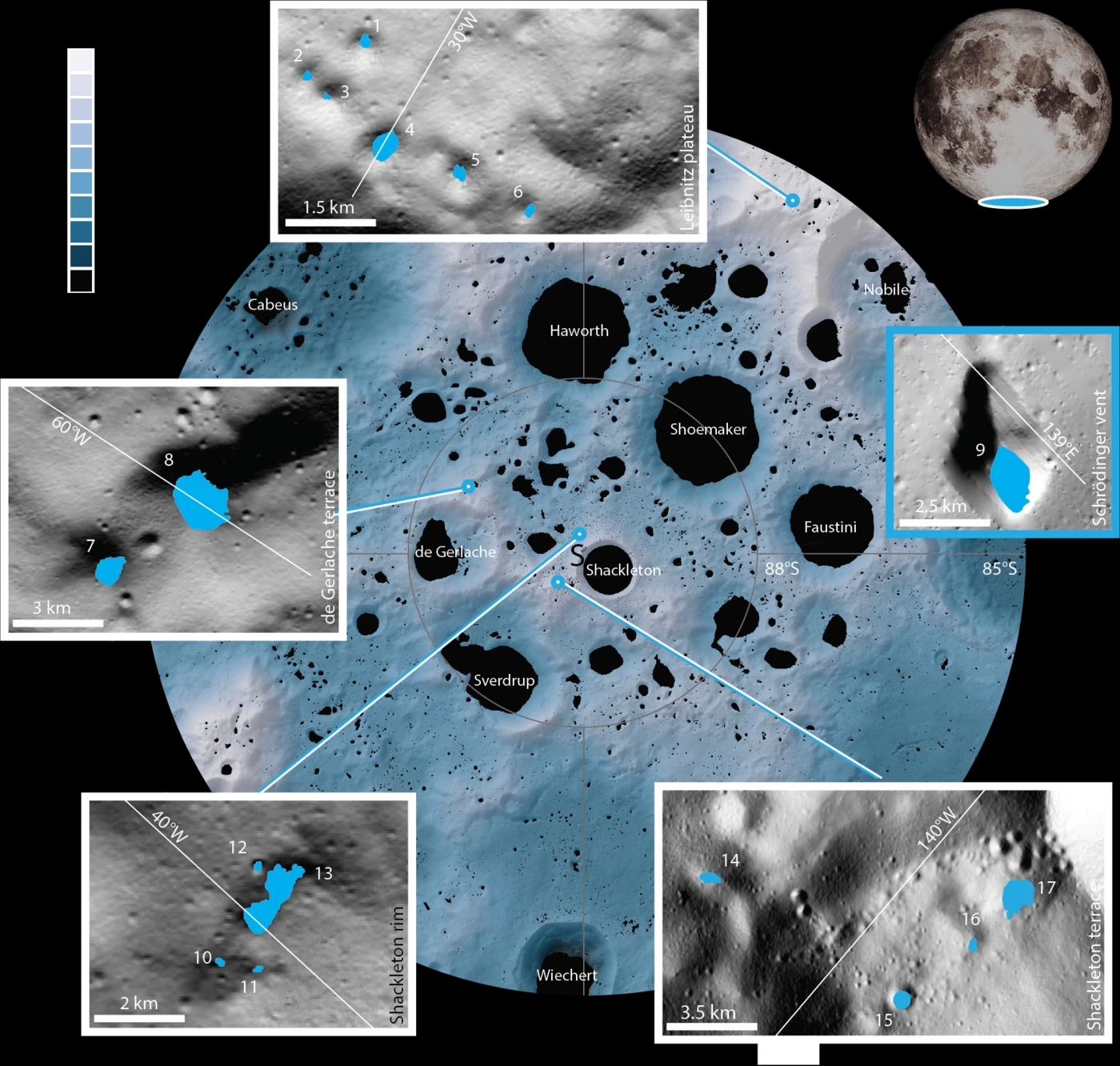
On the Moon, there are a number of craters at the north and south poles that are in permanent shadow. This lack of sunlight means that ice has the ability to build up in these craters. If you’ve watched Apple’s For All Mankind, you know that ice is one of our best hopes for getting water for future astronauts and visitors to the moon.
Before sending people to explore, NASA wants the best possible understanding of the interiors of these craters, and currently, that means sending a rover named VIPER to explore. VIPER is actually an acronym for Volatiles Investigating Polar Exploration Rover, and it will visit the Moon’s south pole in (if all goes well) 2023.
Now, before sending the rover to explore before we send humans, NASA really wants high-quality data of those permanently shadowed craters, and to do that, they are taking images with the Lunar Reconnaissance Orbiter, but I think I mentioned those craters are in permanent shadow, and that makes them hard to image. Hard, however, is not impossible.
Scattered light off the walls of the crater allow just enough light to enter the craters that with enough Photoshop-like image tweaking, you can start to make out what is there. Unfortunately, this process isn’t as fast as TV shows would have us believe, and having humans tweak every image is a time-consuming process. So researchers had humans tweak 70,000 images and then used those 70,000 images to train AI software to tweak future images, and it works.
Researchers can now get a basic idea of what is in these craters, so thanks to images from an orbiter and processing from an AI, NASA will be able to send a rover to explore an area that humans wish to visit. I feel like we need to rewrite the children’s song “The Farmer in the Dell” to be “The Scientists in the Lab” and tell this wild story of trying to explore the Moon.
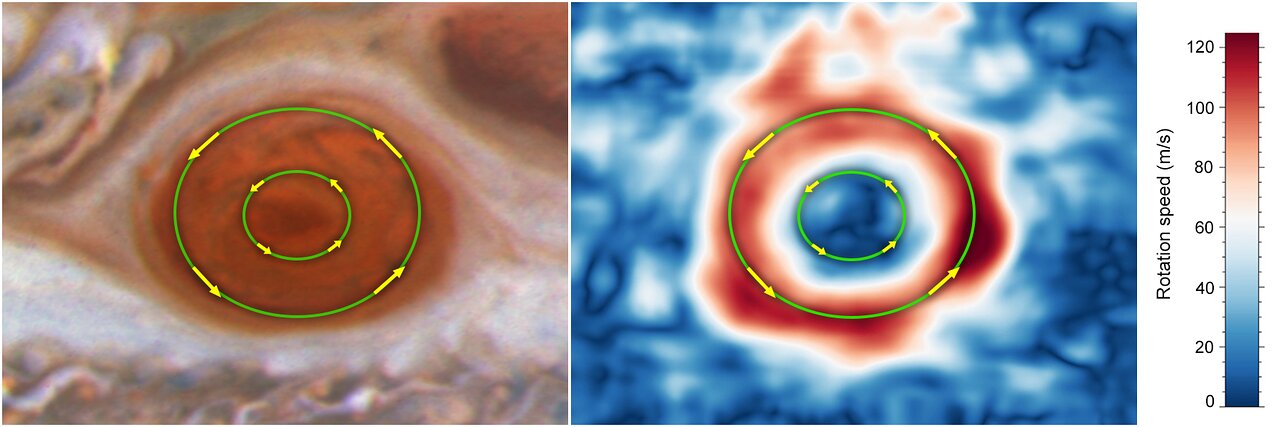
While some research seems to require every possible research tool, others can be done with just one telescope and a whole lot of time. When Hubble first launched, I didn’t have my driver’s license, and fashion was actually identical to what is popular now, but the hairstyles were much bigger. It took a few years and a servicing mission to get Hubble up and running with peak performance, and over the past many decades since then, Hubble has been able to track the changes of various objects around the universe, including objects not too far from home. One of those objects is Jupiter.
Since its final servicing mission in 2009, Hubble has been tracking the speed of winds in Jupiter’s Great Red Spot. In a new paper in Geophysical Research Letters led by M H Wong, researchers show that the outer winds in this seemingly eternal hurricane have been speeding up. While this storm has been there since at least Galileo first looked at Jupiter through a telescope in the early 1600s, the storm hasn’t been unchanging.
In recent decades, we’ve seen the spot’s color change, and for the past 150 years, it has been gradually shrinking. We don’t understand the forces that drive and change this storm, and now we have one more change to try and understand. It turns out that predicting storms is one of the hardest things we can do both here on Earth and out on other worlds across our solar system.
Let’s face it; the universe is full of surprising things.
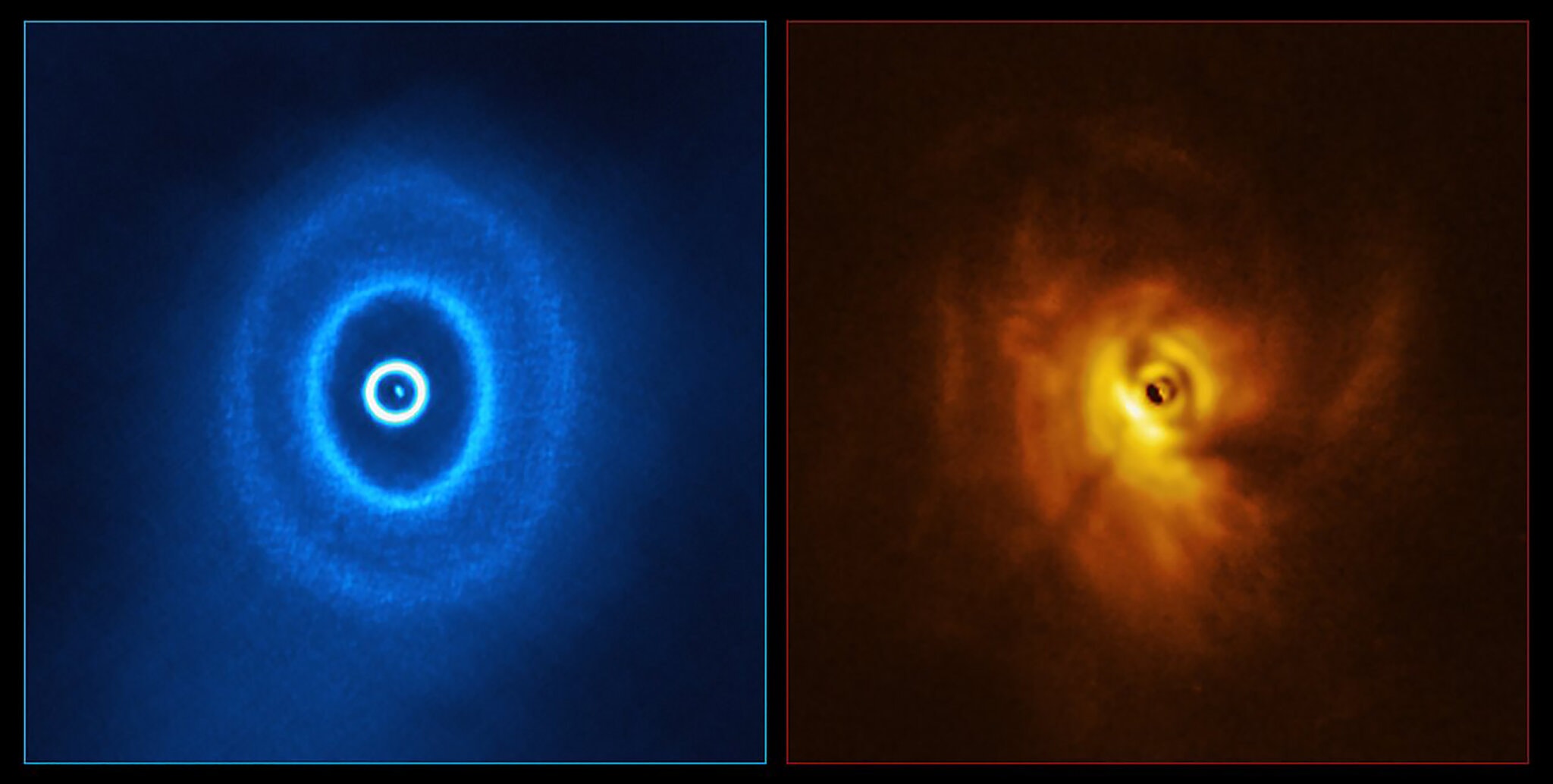
In a new paper led by Jeremy Smallwood and accepted for publication in the Monthly Notices of the Royal Astronomical Society, researchers document their discovery of a planet orbiting a stellar triplet. In the center of this system, GW Ori, are three stars. The inner two are separated by the same distance as the Earth and Sun, and the third star is not quite as far away as Saturn is from our Sun.
This system is only about a million years old, and it is surrounded by three dust rings. These three dust rings aren’t well-aligned, and computer models indicate that to explain what we see, at least one giant planet needs to exist in the gaps of those dust rings. This means we have now found, for the first time, what appears to be a planet or planets orbiting around three stars. And now we need a sci-fi show to show us what this would look like, or I could paint it this weekend.
Pamela, I think you should also paint me a watery Mars. It seems to be the topic of the decade.
In a new paper published in Nature, with lead authors from The University of Texas at Austin and the Planetary Science Institute, researchers found that some of the surface of Mars was shaped by massive floods that overflowed crater rims. These types of crater lakes are not unheard of here on Earth, and while most people are familiar with the more volcanic kind, we do also have examples of meteor craters with lakes. One of the most famous is Manicouagan in Quebec, Canada.
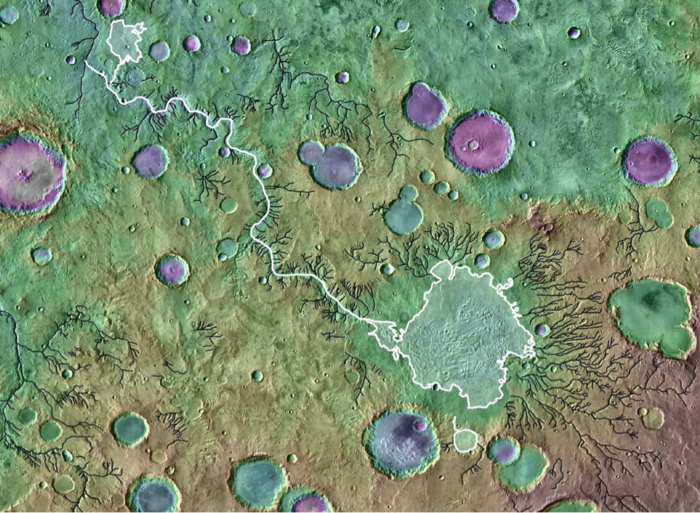
About 3.5 billion years ago, Mars had a lot of water on its surface, including large lakes, some of which were in impact craters. When the water levels got too high, the lakes burst over the crater rims and flowed down onto the flatter surface below, quickly carving out deep canyons. Again, similar flooding occurred here on Earth at the end of the last ice age, where lake waters burst through into the northwestern United States and Central Asia.
If it happens in one place, it happens in others, right? That’s one of those rules we use in geology and astronomy. An example of one leads to more examples. Such is the case with Mars.
This science is a result of analyzing mapped observations of Mars’s current surface and computer modeling to calculate the volume of the valleys. Those volumes were then compared with similar valley networks. PSI research scientist Alex Morgan explains: We found that at least a quarter of the total eroded volume of Martian valley networks were carved by lake breach floods. This high number is particularly striking considering that valleys formed by lake breach floods make up just 3% of Mars’ total valley length. This discrepancy is accounted for by the fact that outlet canyons are significantly deeper than other valleys. These floods would have shaped the overall Martian topography, affecting the flow paths of other valleys. Our results don’t negate the importance of precipitation-fed runoff on early Mars. On the contrary, liquid water had to be stable for long enough for lakes to fill from inlet rivers.
This was the first global analysis of lake overflow flooding done for Mars and helps to understand how the climate changed on Mars and whether it was “warm and wet” or “cold and icy”. I think we can safely say it was warm and wet now. Again, Pamela, want to paint this weekend?
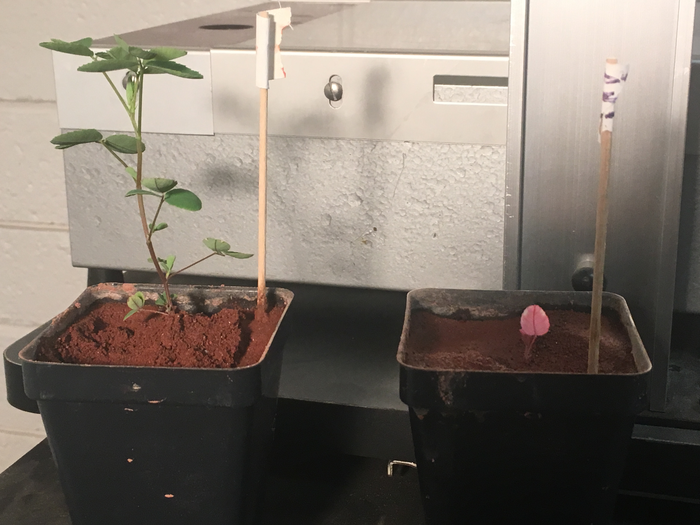
Now, understanding Mars’ warm and wet past is all well and good. But what about its current climate, which is cold and dry. We keep talking about sending humans to Mars. That’s a long journey and requires the ability to do some minor bits of terraforming. Can we really grow potatoes on Mars? Mark Watney did, and while The Martian is a well-researched bit of fiction, it’s still just that: fiction.
However, an experiment run by Franklin Harris at Colorado State University has managed to grow clover plants in Mars-like soil, so maybe fiction isn’t that far from possible fact.
Okay, okay. It’s not that simple. Remember what Mark Watney had to do to make the potatoes grow? Well, Martian soil is missing important components for plant growth, and the experiment provided that missing component by inoculating the soil with symbiotic nitrogen-fixing bacteria. So you absolutely can grow plants in Martian soil, but you have to give it something extra to really make it work.
Just how much improvement did the team see when using the microbes? The clover experienced 75% more growth compared to its control partner, but strangely, they didn’t find any more ammonium ions in the soil of the larger plant. This means that the clover keeps the microbes all to itself and doesn’t help nearby plants. While this method seems to work with this particular plant, we’ll still have to keep experimenting to find out what works for other plants. I wonder if Mark Watney would have enjoyed some clover with his potatoes?
Sometimes it takes a long time to figure out exactly what distant objects in our solar system happen to be doing. Back in 2014, an icy object was discovered by Pedro Bernadinelli and Gary Bernstein while Benadinelli was working on his doctoral research. At the time, this object was about 29 times the Earth’s distance from the Sun; a distance that put it out near Neptune, and since they were looking for trans-Neptunian objects, this object was nice and consistent with what they were looking for. With a diameter estimated around 150 kilometers, it initially looked like a totally normal, fairly boring, apparently round chunk of ice.
But not all was as it seemed.
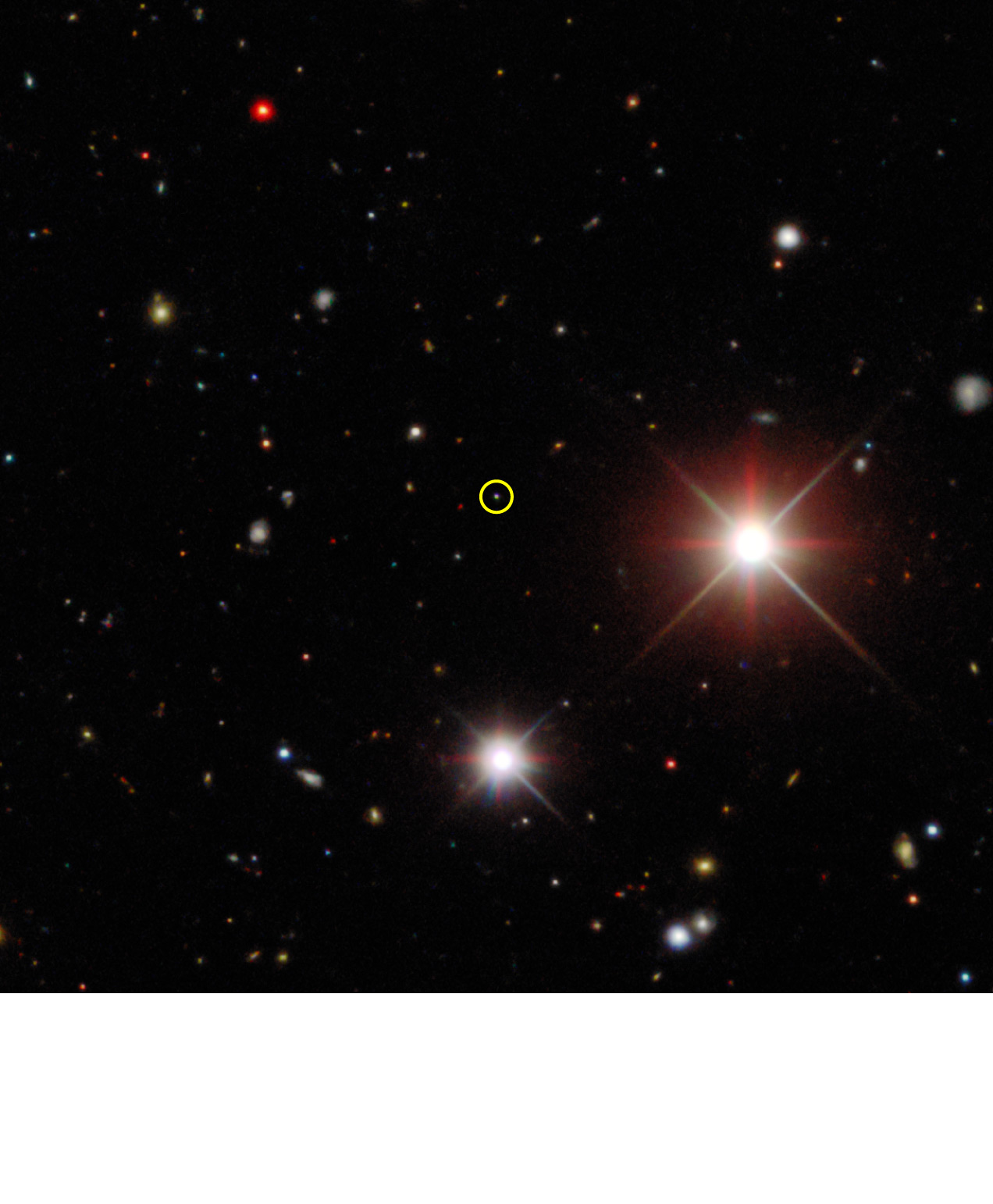
In the years since then, additional observations, with new data from the Dark Energy Survey, and historic images that happened to include this object have allowed researchers to update their understanding of this object’s orbit. That orbit is actually anything but boring. It looks like this object is actually a comet, with an orbit that will carry it inside Saturn’s orbit where it will make its closest approach to the Sun in 2031.
What’s more, this object originates from out toward the outermost edges of our solar system. This orbit is highly elongated, with its greatest distance from the Sun being 4,000 times larger than its closest approach to the Sun.
This is the third comet from the Oort Cloud identified while still on its way in toward the Sun, and it is by far the largest comet seen with modern instruments; comets are typically under a mile to a few miles across – not ninety miles across!
So we have found an object that comes from the outer edges of the solar system that, for comets, is huge, and it is coming our way, but won’t get even as close as Jupiter, so there is no reason to worry. [Ed. note: Beth went off on a rant against clickbait headlines here.]
But there are a lot of reasons to get excited.
We get to watch almost the entire process of the comet lighting up and growing a coma. Already, a coma rich in carbon dioxide and ammonia has been spotted. This object will get bright enough for at least small telescopes, and we have no way of predicting just how bright and amazing this will be! What’s more, there is actually time to possibly launch a mission to this object, but it will require quick action.
Calculations by Adam Hibberd indicate a launch by 2029 is necessary, so everyone get your funding together, and let’s do something amazing. Go!
What’s Up
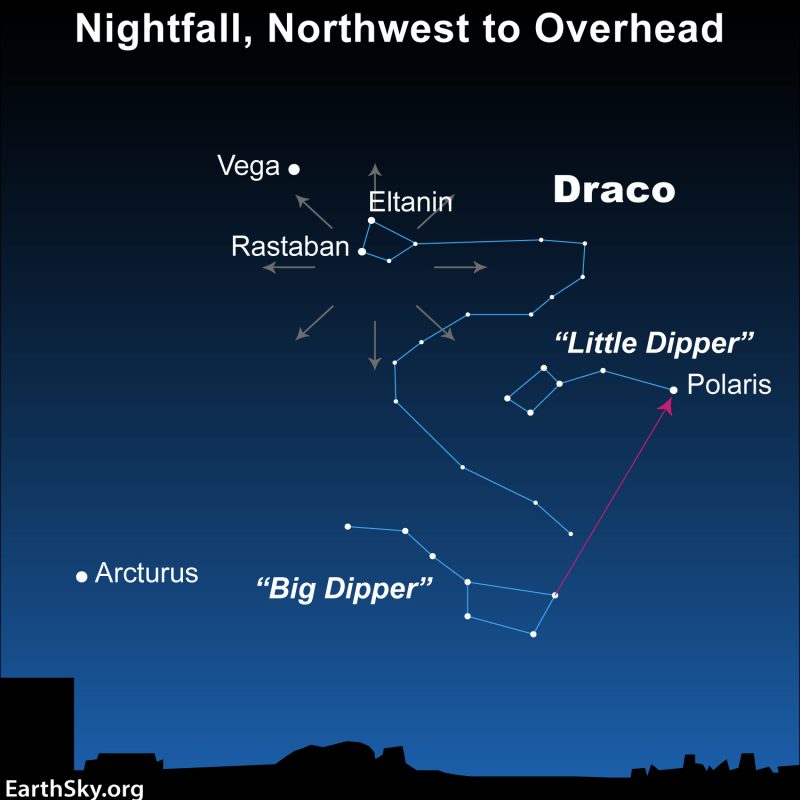
With a closest distance greater than Jupiter’s orbit, this comet will be cool, but it won’t exactly light up our sky. When comets get closer and cross the Earth’s orbit, the debris they leave will trigger meteor showers far into the future. This week in What’s Up is an upcoming meteor shower, the Draconids. This meteor shower is highest in the sky in the evening, which is unusual for meteor showers who mostly peak in the morning. Like I mentioned last week, this one falls around the new moon, and while the moon will be slightly illuminated, it will be below the horizon before midnight, so it will not interfere with viewing the event.
The Draconids typically produce only a handful of meteors an hour in the modern era. In the mid-twentieth century, specifically in 1933 and 1946, they produced some of the most spectacular meteor showers of that century with hundreds of meteors an hour. The Draconids have produced storms with thousands of meteors an hour on several occasions in recorded history.
The apparent point in the sky where the meteors come from – the radiant – is in the constellation Draco, giving the shower its name. To find Draco, first find the Summer Triangle, the asterism formed by Deneb, Vega, and Altair. Follow Vega up and to the right a short distance until you see two dim stars. This is the radiant for the Draconids. We’ll have finding charts at DailySpace.org.
The best way to see a meteor shower is with the unaided eye, the widest field of view you can get. Be sure to let your eyes get well adjusted to the dark; don’t use a planetarium app on your phone. Even if it has a red light function the brightness will impact your dark adaption. You can download a map from a link at our website and print it out to bring with you to the field. Use a proper red light flashlight to see the map when you’re out. You can get one from Amazon using our affiliate link so that we can benefit as well. A reclining chair may also be helpful for remaining comfortable for hours of looking for meteors. I happen to like my hammock.
If you want to try to take pictures of this meteor shower, the best way to do that is to use an interchangeable lens camera with a wide-angle lens, at least 20 millimeters, wider if possible. Mount your camera on a tripod and take very long exposures using bulb mode and a remote shutter release cable (but not an app on your phone because you want to preserve your night vision), and you might capture a few meteors.
The Draconids are also sometimes called the Giacobinids after Michael Giacobini who discovered the comet which is the source of material for the meteor shower, 21P/Giacobini-Zinner. Giacobini discovered it first in 1900 and another man named Ernst Zinner discovered it independently three years later, which is called “recovering” so they both get credit.
This comet has an orbital period of just under seven years. The last close approach to the Sun was in 2018. Every time it gets close to the Sun, the comet gets heated up and sheds debris, which becomes the meteor shower when that debris hits the Earth’s atmosphere.
The International Cometary Explorer (ICE) spacecraft visited Comet 21P back in 1985, becoming the first spacecraft to fly by a comet. ICE also flew by Comet Halley, part of a group of spacecraft to do so. NASA maintained communications with ICE until 1997, nearly twenty years after its launch. Almost twenty years after that, a group of citizen scientists successfully made contact with the spacecraft in 2014 and reactivated some of its systems 36 years after launch.
This has been the Daily Space.
You can find more information on all our stories, including images, at DailySpace.org. As always, we’re here thanks to the donations of people like you. If you like our content, please consider joining our Patreon at Patreon.com/CosmoQuestX.
Credits
Written by Pamela Gay, Beth Johnson and Erik Madaus
Hosted by Pamela Gay and Beth Johnson
Audio and Video Editing by Ally Pelphrey
Content Editing by Beth Johnson
Intro and Outro music by Kevin MacLeod, https://incompetech.com/music/


 We record most shows live, on Twitch. Follow us today to get alerts when we go live.
We record most shows live, on Twitch. Follow us today to get alerts when we go live.